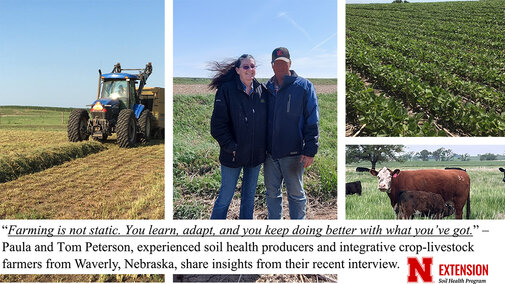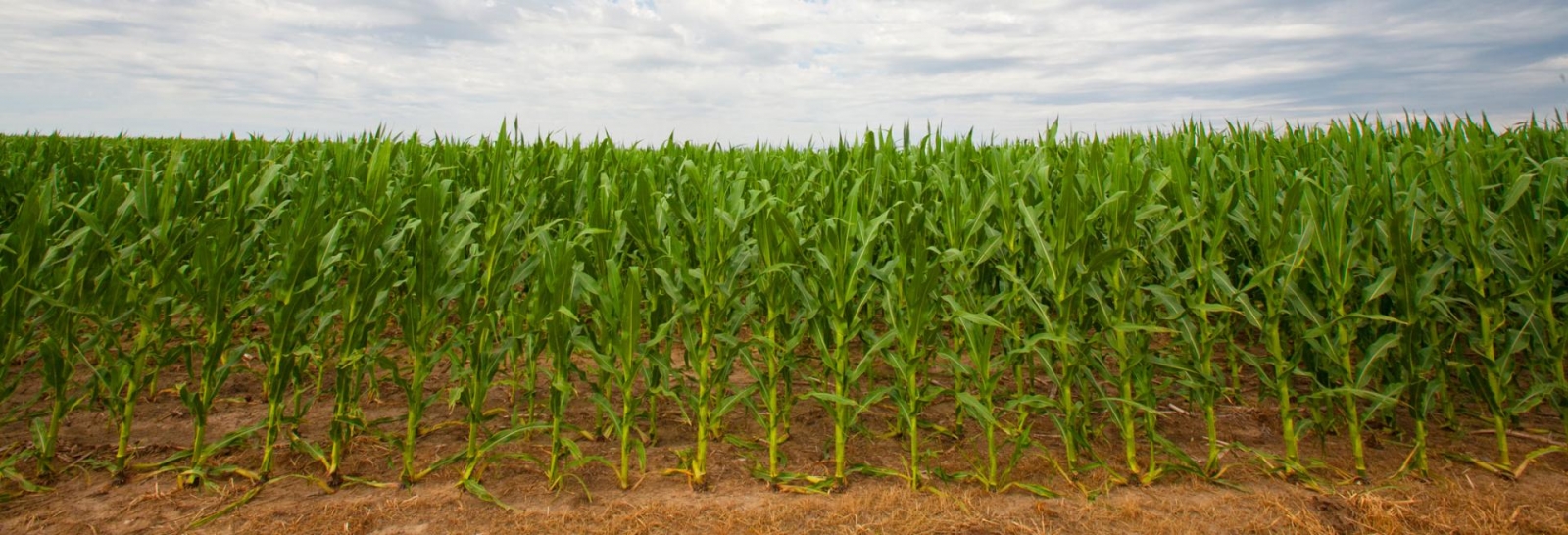This article is part of the "Soil Health Stories" series on CropWatch, featuring Nebraska farmers and ranchers. Each month, we highlight producers who are demonstrating innovative practices and practical lessons that can inspire others across the state.
For nearly four decades, Paula and Tom Peterson have built their farm with an eye on the future from their home near Waverly, Nebraska. Fifth-generation Nebraskan Paula and lifelong farmer Tom have devoted their lives to creating a sustainable operation grounded in stewardship, adaptability and community values. Their story reflects a philosophy shared by many Nebraska producers: caring for the land is inseparable from caring for the family and community that depend on it.
Paula and Tom expressed deep appreciation for the University of Nebraska–Lincoln’s role in supporting farmers through education, research and outreach. Their April 2025 interview with UNL Soil Health Specialist Caro Córdova and three UNL students underscored that connection. Paula’s own background in agricultural business and economics at UNL has shaped her understanding of farming systems, while the couple’s willingness to collaborate with the university and open their farm for experiential learning reflects mutual respect between producers and academia.
“You’re probably going to teach us more than we teach you,” Tom told the students — a sentiment that perfectly captures the spirit of shared learning driving UNL’s soil health efforts.
For the Petersons, soil health is the foundation of both their farm and their family’s legacy. They believe that healthy soil sustains not only crops but also livestock, community and the next generation. Their management approach — anchored in no-till practices, crop rotation, terracing, and precision soil sampling — shows a deep, data-informed commitment to improving soil function and resilience. To them, maintaining soil health is both a practical and moral responsibility: a promise to leave their land better than they found it.

Adapting to Change: From Conventional to No-Till
When the Petersons began farming, fields were worked through deep ripping, chiseling and disking. But around 2011, they made a transformative shift to no-till farming. During an interview in their cozy living room before heading out for a field tour, Tom explained the evolution of their operation.
“We gradually moved from conventional to minimum, and then to no-till,” Tom said. “Now, we really don’t till much at all, except for a few areas where we feed cattle.”
With Nebraska’s variable rainfall, the benefits became clear.
“Those dry years — we’re thankful for no-till. It helps keep moisture in the ground,” he said. “If we still did full tillage, we wouldn’t have a crop in some years.”
Stewarding Water and Soil
The Petersons are steadfast advocates for terracing and crop rotation to reduce erosion and maintain soil structure. Working with the Natural Resources District (NRD) and NRCS, they have installed and maintained terraces on their sloped fields, refining them as new challenges arise.
“Terraces are never ‘one and done,’” Tom said. “Nature changes, new cuts show up, so we adjust. It’s continuous.”
Paula emphasized that crop rotation remains a key strategy.
“We always see benefits from rotating crops — it keeps the soil balanced and healthy for the long haul,” she said.
Their corn, soybean and occasional small-grain rotations, paired with manure management from their cattle, help sustain both soil fertility and farm productivity.
Precision Tools for Productivity
Technology plays a growing role in the Petersons’ operation. The adoption of GPS-guided planting, automatic shut-offs, and variable-rate fertilization has improved both efficiency and resource stewardship.
“We went to GPS when we switched planters in 2011, and that was a big step,” Tom explained. “Now each row shuts off individually, and rates change as we go. It really saves seed and improves yield consistency.”
Paula added that regular soil testing and variable-rate nutrient application are key to sustainability: “We apply nutrients only where they’re needed, so nothing is wasted.”
Financial and Environmental Challenges
Adopting conservation practices can be cost-prohibitive. The Petersons have often turned to NRCS conservation programs, such as EQIP, to help manage expenses for terrace and water management projects.
“Our share on one project years ago was still $75,000,” Paula said. “Cost-share programs help, but the funding is limited. More support would allow more farmers to make these improvements.”
Lessons in Persistence — and Patience
The Petersons have experimented with cover crops, but success has varied due to dry weather.
“Cover crops are great when it rains,” Tom admitted, “but it’s hard when it doesn’t. We’ve seen rye dry out the soil before beans, and we just didn’t get the rain we needed.”
Despite the challenges, the Petersons remain committed to continuous improvement.
“Farming’s not static,” Tom reflected. “You learn, you adapt, and you keep doing better with what you’ve got.”
Key Takeaways for Producers
- Start small but plan for the long term. Transitioning to no-till or terracing takes time but builds resilience.
- Use technology wisely. Precision tools make conservation more efficient and profitable.
- Invest in soil testing. Knowing what your soil needs prevents waste and ensures sustainability.
- Stay adaptive. Conditions change — successful conservation evolves with them.
- Partner up. Collaboration with NRD, NRCS and Nebraska Extension brings expertise and funding support.
Looking Ahead
As Paula summarized, the ultimate goal is legacy: “We want this land to produce for future generations of our family.”
Their story embodies the spirit of Nebraska farming — where innovation, practicality and love for the land come together in the shared work of stewardship.
More Information
Want to hear The Peterson’s full story in their own words? Listen to the complete interview recording:
The Petersons’ welcomes growers to reach out via email. Please refer to this article for more context when emailing them.
Share Your Soil Health Story
For more Soil Health Stories, or to share your own, contact the UNL Soil Health Team:

